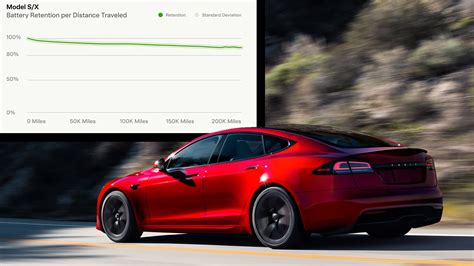
Tesla batteries are proving remarkably durable, with many surpassing 200,000 miles and retaining significant capacity, challenging the myth that electric vehicle batteries degrade rapidly, according to automotive expert Scotty Kilmer.
Tesla Batteries Exceed 200,000 Miles, Shattering EV Longevity Concerns
A pervasive concern among prospective electric vehicle (EV) buyers is the lifespan and durability of their batteries. However, automotive expert Scotty Kilmer is challenging this narrative, highlighting numerous Tesla vehicles that have surpassed the 200,000-mile mark while maintaining robust battery performance. This revelation directly addresses the apprehension that EV batteries are prone to rapid degradation, offering a more optimistic perspective on the long-term viability of electric cars.
Kilmer’s analysis, drawing from real-world examples and owner experiences, suggests that Tesla batteries are far more resilient than commonly believed. “People think after 100,000 miles, electric car batteries are toast. That’s simply not true, ” Kilmer states. He points to numerous anecdotal cases and available data indicating that Tesla batteries can endure significant mileage while retaining a substantial portion of their original capacity.
Real-World Examples and Data Points
While precise degradation rates vary based on factors such as driving habits, charging patterns, and environmental conditions, the evidence indicates a trend of considerable battery longevity. Owners of Tesla Model S and Model X vehicles, among others, have reported minimal capacity loss even after extensive use. Data from various sources, including owner forums and independent testing, supports the assertion that Tesla batteries can maintain 80-90% of their original capacity after exceeding 200,000 miles.
One compelling example is that of a Tesla Model S owner who logged over 400,000 miles with minimal battery degradation. This instance, while anecdotal, showcases the potential lifespan achievable with proper care and maintenance. Additionally, numerous reports highlight fleets of Tesla vehicles used for ride-sharing services that have accumulated high mileage with satisfactory battery performance.
Factors Influencing Battery Longevity
Several factors contribute to the extended lifespan of Tesla batteries. Tesla employs advanced battery management systems (BMS) that monitor and regulate battery health. These systems optimize charging and discharging cycles, preventing overcharging and deep discharging, which can accelerate degradation. The BMS also actively manages temperature, ensuring the battery operates within optimal thermal ranges, crucial for maintaining its long-term health.
“Temperature is the enemy of batteries,” Kilmer explains. Tesla’s thermal management systems, which utilize liquid cooling, play a vital role in mitigating the impact of extreme temperatures on battery performance and longevity. This sophisticated cooling system helps maintain consistent cell temperatures, reducing the risk of thermal runaway and degradation.
Another crucial aspect is the battery chemistry itself. Tesla utilizes lithium-ion batteries, specifically Nickel Cobalt Aluminum (NCA) and Lithium Iron Phosphate (LFP) chemistries in various models. These chemistries offer high energy density and relatively long cycle lives compared to other battery technologies. The NCA chemistry, commonly found in older Tesla models, provides excellent energy density, while the LFP chemistry, increasingly used in newer models, offers enhanced thermal stability and cycle life, albeit with slightly lower energy density.
Driving habits and charging practices also significantly impact battery longevity. Frequent rapid charging (DC fast charging) can accelerate battery degradation compared to Level 2 charging. Similarly, consistently discharging the battery to very low levels or charging it to 100% can reduce its lifespan over time. Adopting moderate charging habits, such as charging to 80-90% and avoiding deep discharges, can help prolong battery life.
Challenging the Misconceptions
The myth of rapid battery degradation in EVs stems from early experiences with older battery technologies and limited data on the long-term performance of EV batteries. Initial concerns about battery lifespan were fueled by comparisons to traditional internal combustion engine (ICE) vehicles, where engine longevity is often measured in hundreds of thousands of miles. However, EV battery technology has advanced significantly in recent years, resulting in improved durability and lifespan.
Another contributing factor is the lack of transparency regarding battery health and degradation. Many EV owners are unsure how to accurately assess their battery’s performance and may rely on anecdotal evidence or misinformation. Tesla provides tools and data to monitor battery health, but greater standardization and transparency across the EV industry are needed to address this issue.
Economic Implications
The extended lifespan of Tesla batteries has significant economic implications for EV owners. One of the primary concerns regarding EV ownership is the potential cost of replacing the battery pack. If batteries last significantly longer than anticipated, the total cost of ownership for EVs becomes more competitive with ICE vehicles. A durable battery reduces the risk of costly replacements and contributes to lower overall maintenance expenses.
Furthermore, the long lifespan of Tesla batteries enhances the resale value of these vehicles. Potential buyers are more likely to invest in a used EV if they are confident that the battery will retain a significant portion of its capacity. This increased resale value makes EVs a more attractive long-term investment.
Industry-Wide Implications
The success of Tesla batteries in achieving high mileage and maintaining capacity has broader implications for the entire EV industry. It demonstrates the potential for long-lasting EV batteries and encourages other manufacturers to invest in research and development to improve battery technology. As battery technology advances, the lifespan and durability of EV batteries will continue to improve, making EVs an increasingly viable and sustainable transportation option.
The focus on battery longevity also drives innovation in battery chemistry, thermal management systems, and battery management software. Manufacturers are actively exploring new battery chemistries, such as solid-state batteries, which promise even greater energy density, safety, and lifespan. Advancements in thermal management systems are aimed at maintaining optimal battery temperatures under a wider range of operating conditions. Sophisticated battery management software optimizes charging and discharging cycles, maximizing battery lifespan and performance.
The Future of EV Batteries
The future of EV batteries looks promising, with ongoing research and development focused on improving energy density, lifespan, and safety. Solid-state batteries, in particular, are expected to revolutionize the EV industry by offering significantly higher energy density and improved safety compared to current lithium-ion batteries. These batteries utilize a solid electrolyte instead of a liquid electrolyte, eliminating the risk of leaks and thermal runaway.
Another area of focus is battery recycling. As the number of EVs on the road increases, the need for effective battery recycling processes becomes more critical. Recycling batteries allows for the recovery of valuable materials, such as lithium, cobalt, and nickel, reducing the reliance on mining new resources and minimizing environmental impact. Several companies are developing innovative battery recycling technologies that promise to recover a high percentage of valuable materials.
In conclusion, the evidence suggests that Tesla batteries are capable of exceeding 200,000 miles while maintaining significant capacity, challenging the myth of rapid battery degradation. Factors such as advanced battery management systems, sophisticated thermal management, and durable battery chemistries contribute to this extended lifespan. This revelation has significant economic implications for EV owners and broader implications for the entire EV industry, driving innovation and making EVs an increasingly viable and sustainable transportation option. While individual results may vary, the overall trend indicates that EV batteries are far more resilient than commonly believed, offering a more optimistic perspective on the long-term viability of electric vehicles. 5 Frequently Asked Questions (FAQ) about Tesla Battery Longevity
Q1: How long do Tesla batteries typically last before needing replacement?
A: While individual results may vary depending on driving habits, charging patterns, and environmental conditions, many Tesla batteries are lasting well beyond 200,000 miles and maintaining a significant portion of their original capacity (80-90%). Some owners have even reported exceeding 400,000 miles with minimal degradation. The lifespan is influenced by factors such as the battery management system (BMS), thermal management, and battery chemistry (NCA or LFP). Tesla batteries are designed to last for many years, and the need for replacement is becoming less common than initially anticipated.
Q2: What factors contribute to the longevity of Tesla batteries?
A: Several factors contribute to the extended lifespan of Tesla batteries:
- Advanced Battery Management System (BMS): The BMS monitors and regulates battery health, optimizing charging and discharging cycles and preventing overcharging and deep discharging.
- Thermal Management System: Tesla’s liquid cooling system maintains consistent cell temperatures, mitigating the impact of extreme temperatures on battery performance and longevity.
- Battery Chemistry: Tesla utilizes lithium-ion batteries, specifically Nickel Cobalt Aluminum (NCA) and Lithium Iron Phosphate (LFP) chemistries, which offer high energy density and relatively long cycle lives.
- Charging Habits: Moderate charging habits, such as charging to 80-90% and avoiding deep discharges, can help prolong battery life.
- Driving Conditions: Consistent and moderate driving can reduce strain on the battery.
Q3: Does frequent DC fast charging negatively impact Tesla battery life?
A: Yes, frequent DC fast charging can accelerate battery degradation compared to Level 2 charging. DC fast charging generates more heat, which can negatively impact battery lifespan over time. It is recommended to use DC fast charging sparingly and rely on Level 2 charging for regular use.
Q4: How can I monitor the health of my Tesla battery?
A: Tesla provides tools and data to monitor battery health through the Tesla app and vehicle interface. Owners can track the battery’s state of charge, estimated range, and overall performance. While a precise measure of remaining capacity isn’t directly displayed, changes in range over time can indicate potential degradation. Third-party apps and services are also available that offer more detailed battery health analysis, but their accuracy may vary. Regular observation of charging behavior and range can provide insights into the battery’s condition.
Q5: What are the economic implications of long-lasting Tesla batteries?
A: The extended lifespan of Tesla batteries has significant economic benefits for EV owners:
- Reduced Replacement Costs: Longer battery life reduces the risk of costly battery replacements, lowering the total cost of ownership.
- Higher Resale Value: EVs with durable batteries command higher resale values, making them a more attractive long-term investment.
- Lower Maintenance Expenses: Durable batteries contribute to lower overall maintenance expenses, as there is less need for frequent repairs or replacements.
- Increased Affordability: As battery technology improves and lifespan increases, the overall affordability of EVs improves, making them more accessible to a wider range of consumers. Expanded Detail & Background Information
The narrative surrounding electric vehicle (EV) battery longevity has been rife with uncertainty and, at times, misinformation. Initial concerns were rooted in limited data and comparisons to the established internal combustion engine (ICE) vehicle market, where engine lifespans are commonly projected to surpass 200,000 miles. However, EV battery technology has rapidly evolved, and the latest data, coupled with real-world experiences, paints a far more optimistic picture. Scotty Kilmer’s analysis adds to the growing body of evidence suggesting that Tesla, and potentially other EV manufacturers, are producing batteries that can withstand significant mileage without substantial degradation.
Historical Context of Battery Concerns
The early days of EVs were marked by significant concerns about battery technology. Battery range was limited, charging infrastructure was sparse, and the long-term durability of battery packs was largely unknown. These uncertainties contributed to consumer hesitation and slowed the adoption of EVs. Initial reports of battery degradation in early EV models fueled these concerns, further solidifying the perception that EV batteries were a weak link in the overall vehicle design.
Many early EV batteries used different chemistries and lacked the sophisticated battery management systems that are commonplace today. These factors contributed to faster degradation and shorter lifespans. Additionally, the lack of widespread charging infrastructure meant that early EV owners often relied on rapid charging more frequently, which, as mentioned earlier, can accelerate battery degradation.
The Evolution of Battery Technology
Over the past decade, EV battery technology has undergone a dramatic transformation. Advancements in battery chemistry, thermal management, and battery management systems have significantly improved battery performance, lifespan, and safety.
Battery Chemistry Advancements:
Lithium-ion batteries remain the dominant technology in the EV market, but significant improvements have been made to the specific chemistries used. Tesla primarily uses Nickel Cobalt Aluminum (NCA) and Lithium Iron Phosphate (LFP) batteries. NCA batteries offer high energy density, allowing for longer driving ranges, while LFP batteries are known for their enhanced thermal stability and longer cycle life. Other manufacturers are exploring alternative chemistries, such as Nickel Manganese Cobalt (NMC) and solid-state batteries, to further improve battery performance.
Solid-state batteries are particularly promising, as they offer the potential for even higher energy density, improved safety, and longer lifespan compared to current lithium-ion batteries. Solid-state batteries replace the liquid electrolyte found in traditional lithium-ion batteries with a solid electrolyte, eliminating the risk of leaks and thermal runaway. While solid-state battery technology is still under development, it is expected to play a major role in the future of EVs.
Thermal Management Systems:
Effective thermal management is crucial for maintaining battery health and longevity. Batteries operate best within a specific temperature range, and extreme temperatures can accelerate degradation. Tesla utilizes liquid cooling systems to regulate battery temperature, ensuring that the battery operates within optimal thermal ranges. These systems circulate coolant through the battery pack, removing heat and preventing overheating.
Other manufacturers employ different thermal management strategies, such as air cooling or a combination of air and liquid cooling. The choice of thermal management system depends on factors such as battery chemistry, vehicle design, and cost considerations.
Battery Management Systems (BMS):
The BMS is a sophisticated electronic system that monitors and controls the battery pack. The BMS performs several critical functions, including:
- Monitoring cell voltage and temperature: The BMS continuously monitors the voltage and temperature of each individual cell in the battery pack, ensuring that they remain within safe operating limits.
- Balancing cell charge: The BMS balances the charge of individual cells to prevent overcharging or undercharging, which can damage the battery.
- Optimizing charging and discharging: The BMS controls the charging and discharging process to maximize battery lifespan and performance.
- Protecting against overcurrent and overvoltage: The BMS protects the battery pack from overcurrent and overvoltage conditions, which can damage the battery or create a safety hazard.
- Estimating state of charge (SOC) and state of health (SOH): The BMS estimates the battery’s state of charge (SOC), which indicates the remaining capacity, and state of health (SOH), which indicates the overall condition of the battery.
The Role of Driving and Charging Habits
While battery technology plays a crucial role in battery longevity, driving and charging habits also have a significant impact. Aggressive driving, frequent rapid charging, and extreme temperatures can all accelerate battery degradation.
Aggressive Driving:
Aggressive driving, characterized by rapid acceleration and hard braking, can put significant stress on the battery. Frequent acceleration and deceleration cycles can generate heat, which can negatively impact battery lifespan. Driving at high speeds for extended periods can also increase battery temperature and accelerate degradation.
Charging Habits:
Charging habits have a significant impact on battery longevity. Frequent rapid charging (DC fast charging) can accelerate battery degradation compared to Level 2 charging. Rapid charging generates more heat, which can damage the battery over time. It is generally recommended to use DC fast charging sparingly and rely on Level 2 charging for regular use.
Consistently discharging the battery to very low levels or charging it to 100% can also reduce its lifespan. Deep discharges can stress the battery, while charging to 100% can accelerate degradation. It is generally recommended to charge the battery to 80-90% and avoid deep discharges.
Environmental Conditions:
Extreme temperatures can negatively impact battery performance and longevity. High temperatures can accelerate battery degradation, while low temperatures can reduce battery capacity and performance. It is generally recommended to park the vehicle in a shaded area during hot weather and to preheat the battery before driving in cold weather.
Extending Battery Life: Practical Tips for EV Owners
EV owners can take several steps to extend the life of their battery:
- Avoid aggressive driving: Drive smoothly and avoid rapid acceleration and hard braking.
- Use Level 2 charging for regular charging: Rely on Level 2 charging for daily charging and use DC fast charging sparingly.
- Charge to 80-90%: Avoid charging the battery to 100% unless necessary for a long trip.
- Avoid deep discharges: Try to avoid discharging the battery to very low levels.
- Park in shaded areas during hot weather: Protect the battery from extreme heat by parking in shaded areas.
- Preheat the battery before driving in cold weather: Preheat the battery to improve performance and range in cold weather.
- Follow the manufacturer’s recommendations: Follow the manufacturer’s recommendations for battery care and maintenance.
Industry Standards and Transparency
One of the challenges in assessing EV battery longevity is the lack of standardized testing and reporting procedures. Different manufacturers use different methods for measuring battery degradation, making it difficult to compare battery performance across different models. Greater standardization and transparency in battery testing and reporting would help consumers make more informed decisions about EV purchases.
Several organizations are working to develop standardized testing protocols for EV batteries. These protocols aim to provide a consistent and reliable way to measure battery performance and lifespan. Increased transparency in battery reporting would also help consumers understand the long-term performance of EV batteries.
The Economic and Environmental Benefits of Long-Lasting Batteries
The extended lifespan of EV batteries has significant economic and environmental benefits.
Economic Benefits:
- Reduced total cost of ownership: Longer battery life reduces the need for costly battery replacements, lowering the total cost of ownership for EVs.
- Increased resale value: EVs with durable batteries command higher resale values, making them a more attractive long-term investment.
- Lower maintenance costs: Durable batteries contribute to lower overall maintenance costs, as there is less need for frequent repairs or replacements.
Environmental Benefits:
- Reduced resource consumption: Longer battery life reduces the need to manufacture new batteries, reducing the consumption of raw materials and energy.
- Lower greenhouse gas emissions: Longer battery life reduces the greenhouse gas emissions associated with battery production and disposal.
- Reduced waste: Longer battery life reduces the amount of battery waste that ends up in landfills.
The Future of Sustainable Transportation
The extended lifespan of EV batteries is a crucial step towards a more sustainable transportation future. As battery technology continues to improve, EVs will become even more affordable, reliable, and environmentally friendly. This will accelerate the adoption of EVs and help reduce our reliance on fossil fuels. The continued innovation in battery technology, coupled with responsible driving and charging habits, will pave the way for a cleaner and more sustainable transportation system for future generations.









